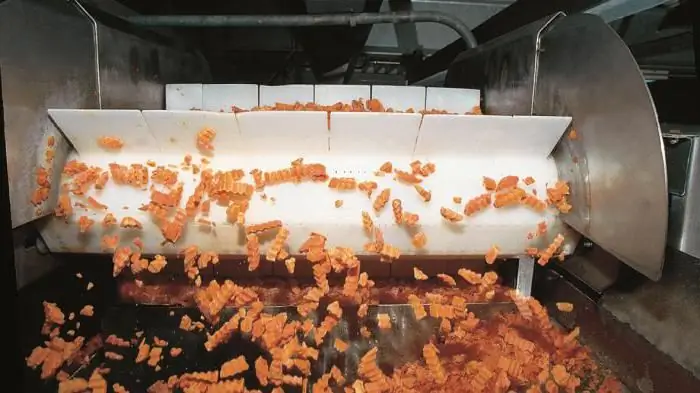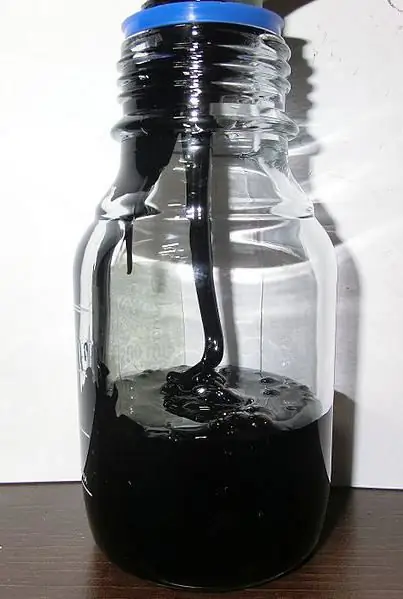2025 Author: Howard Calhoun | [email protected]. Last modified: 2025-01-24 13:10:41
Kazakhstan occupies a leading position in the world in the extraction of high-quality black gold. Oil production in Kazakhstan is carried out in the western regions of the country. According to experts, high-class valuable mineral reserves will last for several more centuries.
Kashagan
This is the name of one of the largest oil fields in Kazakhstan, it ranks ninth in the ranking of the largest wells in the world and the first in terms of complexity. Underground natural storages were found 80 km from the city of Atyrau in the early 2000s. Despite the difficult terrain, the specialists managed to create optimal conditions for oil production and refining.

Kashagan is the first field located in that part of the Caspian Sea, which belongs to the republic. It is the largest investment project in the country. The field got its name in honor of the Kazakh poet Kashagan Kurzhimanuly. In the year of the opening of this project, the country celebrated the 150th anniversary of its birth.
In September 2016, commercial oil production began at Kashagan. This event has becometurning points in the development of the economy of Kazakhstan. A month later, Kazakh crude oil flowed through pipes for export to a number of European countries through the Black Sea city of Novorossiysk. In the future, it is planned to increase the number of export routes, including through Baku and Tbilisi.
Tengiz
In 1979, a group of scientists discovered a large oil and gas field, which was named Tengiz, 350 km from the city of Atyrau. It became the second largest in the country after Kashagan. After accurate exploration of the deposits, the construction of an oil refinery complex began, which took about ten years. The first developer of the new field, by mutual agreement of the leaders (Mikhail Gorbachev and Nursultan Nazarbayev), was the American company Chevron.
Initially, the share of Kazakhstan was 50%, but then part of it was sold to the American company Exxon Mobil. Today, Kazakhstan owns a fifth share, which is managed by the state-owned Kazmunaigas company. Since the launch of the first batch of oil in Kazakhstan, its own brand of this natural fuel, Tengiz, has appeared.

Tengiz disaster
June 23, 1985 was a black day in the history of Kazakhstan. While working on oil well No. 37, an unforeseen event occurred: loss of drilling fluid. A huge fountain of crude oil escaped from a depth of 4.5 thousand meters. The high pressure and the maximum content of by-products in the form of gas led to the sudden ignition of the fountain.
Mosta large oil field in Kazakhstan was engulfed in flames, which fire fighting specialists could not cope with for almost a year. At that time, incidents of this magnitude were not publicized. Today, all the details of the disaster have been made public. Experts say that back in 1985 there were no training manuals for extinguishing oil and gas fountains, there was no equipment and equipment. It was impossible to get closer than 400 meters to the burning torch. There was no technology. The air temperature was around 100 degrees Celsius.
The problem was solved almost a year after the construction of 13 km of water pipeline to cool the metal structures. This allowed the bombers to approach a safe distance and lay TNT charges. Thus, a gradual preservation of the fountain was carried out. The well was fully cemented after 400 days.
Karachaganak
Oil production in Kazakhstan reached a new level with the discovery in 1979 of a new field in the West Kazakhstan region. It was named Karachaganak, which means "black bay" in Kazakh. It is located practically on the border of Kazakhstan and Russia. The nearest cities are 30 km and 115 km, these are Aksai and Uralsk, respectively. Industrial complexes are located on the territory of almost 200 km both on land and on the Caspian Sea.

Full-scale development began in 1980. Then all the work was carried out under the guidance of the industrial associationOrenburggazprom. Today, oil production and refining belongs to Karachaganak Petroleum Operating Joint-Stock Company.
Zhetybay
This project is one of the largest oil and gas fields in Kazakhstan. Opened on July 5, 1961, within eight years it began to produce the first oil and high-quality natural gas. The well here is one of the few that is at the stage of late development. Oil reserves in this area are approximately 70 million tons from the original 345 million. The development center is located in the city of Aktau on the shores of the Caspian Sea.

Atyrau Oil Refinery
Oil refining in Kazakhstan is carried out at the highest level. The oil industry is the most important part of the country's economy, so the heads of enterprises pay great attention to technical equipment.
Atyrau black gold processing plant is one of the three largest enterprises in Kazakhstan. Oil is supplied uninterruptedly. The complex was built during two difficult war years, and the first production was already in 1945. The technical side of the project was developed by the American company Badger and Sons, which was considered the best in this area. The project was already corrected by Soviet specialists, focusing on the geophysical data of the region.
At first, the production capacity was very small, only about 800 thousand tons per year. In this case, foreign chemical elements were used. Two decades later, the company's management began to introduce newdevelopments and technologies. This improved production capacity and gave impetus to a new direction. All necessary auxiliary elements began to be produced on the territory of Kazakhstan. To date, Kazmunaigas owns a controlling stake in the Atyrau Refinery.
Pavlodar petrochemical plant
KazMunayGas National Company is the sole owner of another powerful oil refinery. Kazakhstan produces fuel products not only for domestic use, but also for export. The Pavlodar complex is the leader in terms of the number of modern technologies introduced at the enterprises of the country.
The plant started operating in 1978. A distinctive feature of this enterprise is the processing of oil according to the fuel option, that is, the production is aimed at the complete conversion of refined oil into fuel materials such as gasoline and kerosene. PNZ meets the norm by 30% of the total volume of oil refining in the country. In terms of technology, the plant is focused on working with the West Siberian type of black gold.

Shymkent Oil Refinery
Extensive oil reserves in Kazakhstan require its fast and high-quality processing. Therefore, in the south of the country in the city of Shymkent, a third oil refinery was built. Compared with the Pavlodar and Atyrau complexes, the Shymkent one is the youngest. It was built in 1985.
In addition to refining our own oil products, which account for 30% of the totalvolume, capacity of the plant allow you to accept raw materials from third parties. The resulting products are of high quality. Modern technical equipment makes it possible to obtain a wide range of petroleum products:
- Petrol.
- Fuel oil.
- Aviation kerosene.
- Diesel fuel.
- Liquefied gas.
- Gas oil.
- Sulfur.
The capacity of the Shymkent plant is about 40.6 million barrels per year. In addition, the nearest plans include the development and improvement of fuel quality to the European Euro-4 standard.

Oil reserves
On the territory of Kazakhstan there are more than two hundred large oil and gas fields. The bulk of hydrocarbon raw materials is located in the western part of the country. This is the region of the Caspian Sea. According to preliminary estimates of experts, the volume of oil deposits is approximately 12-13 billion tons. Such oil reserves in Kazakhstan put it in the top ten world leaders in terms of black gold reserves after a number of Arab countries, the USA, Russia and South America. The main stocks of raw materials are concentrated in the following fields:
- Kashagan. The reserves of the deposit are about 4 billion tons.
- Tengiz. Has about 1.2 billion tons of oil.
- Karashyganak. According to experts, the reserves of this field are about 1.2 billion tons of oil and 1.3 trillion cubic meters of gas.
- Uzen. It has 1.1 billion tons of black gold in its depths.
- Geological oil reserves in the Kalamkas fieldhave more than 500 million tons of raw materials.
- Zhetybay. This is a large deposit. The volume of stocks of raw materials is 345 million tons.
Despite the huge volumes of oil produced, Kazakhstan buys a significant part of gasoline (very important in social terms and for the entire economy of raw materials) in Russia. This is due to the prices of gasoline production, excise taxes and the country's domestic trade policy.
Most people believe that the more oil produced in a country, the cheaper gasoline should be. This is relevant only for countries with a low level of social development.
Oil in Kazakhstan is concentrated mainly in 15 officially explored and approved for development basins. Large industrial production is carried out only in five regions: the Caspian, Yuzhnomangyshlak, Ustyurt-Buzashinsky, Yuzhno-Torgai and Shusarysuysky. Work is carried out here at more than a hundred fields. According to official data, oil production in Kazakhstan is carried out only on 65% of the total reserves.
Prospects
During the collapse of the USSR, Kazakhstan was in the third ten countries that produce oil. Gaining independence brought significant changes to the industrial sector of the country. Within the first ten years, Kazakhstan entered the top ten oil-producing countries in the world. Production increased almost five times. The opening of the Kashagan field increased the production of raw materials by another three times over the period of 2017-2018.
Now the country's oil sector is at its peak. It is planned that by 2025 about 110 million tons of oil will be produced. However, after that, the level of production will begin to decline - experts say so. This is due to the gradual full development of the first discovered deposits. By 2050, there will be significantly less oil produced in Kazakhstan. What volumes do analysts predict? In the worst case scenario, they will amount to 40-50 million tons per year.

Gasoline grades
Four grades of gasoline are currently produced in the country for import and export:
- AI-80.
- AI-92.
- AI-95.
- AI-98.
As you know, the letter "A" in the marking means that the fuel is only suitable for cars. The letter "I" indicates that all studies on the quality of gasoline were carried out in laboratory conditions. The number is the octane number. The higher it is, the better the gasoline.
AI-80, AI-92 and AI-95 grades, as well as diesel and aviation fuel, are mainly produced at the Atyrau refinery. The Pavlodar plant specializes in the production of AI-92 and AI-95 gasoline.
Gas lubricants
Until 2010, oil and gas in Kazakhstan were produced and processed in sufficient quantities. However, at the same time, there was no production complex for the manufacture of lubricating motor oils in the country. The required quantity of the product was purchased from abroad.
The problem was solved with the construction of a new enterprise "Hill" in Shymkent, which intends to produce more than 70 thousand tons of high-quality motor oils per year. It will coverabout 30% of the volume required for the country, but even this will bring the state a profit of several hundred million dollars.
The plant is built and equipped with the latest technology. The production of different types of oils (hydraulic, turbine, motor) is carried out at the highest level and costs 10% cheaper than imported. The main customers are the state-owned corporations Kazmunaigas and Intergas.
Recommended:
Meat: processing. Equipment for meat and poultry processing. Production, storage and processing of meat

Information of state statistics show that the volume of meat, milk and poultry consumed by the population has significantly decreased in recent years. This is caused not only by the pricing policy of manufacturers, but also by the banal shortage of these products, the required volumes of which simply do not have time to produce. But meat, the processing of which is an extremely profitable business, is very important for human he alth
Oil is a mineral. Oil deposits. Oil production

Oil is one of the world's most important minerals (hydrocarbon fuel). It is a raw material for the production of fuels, lubricants and other materials
Oil production in the world. Oil production in the world (table)

The world as we know it would be very different if there was no oil. It is hard to imagine how many everyday things are created from oil. Synthetic fibers that make up clothing, all plastic used in everyday life and industry, medicines, cosmetics - all this is created from oil. Almost half of the energy consumed by mankind is produced from oil. It is consumed by aircraft engines, as well as almost all vehicles in the world
Khar'yaginskoye field. Oil field in the Nenets Autonomous Okrug

The Kharyaginskoye field is one of the main oil fields in the Nenets Autonomous Okrug. For several decades of its history, it has changed operators several times
Transport taxes in Kazakhstan. How to check transport tax in Kazakhstan? Deadlines for paying transport tax in Kazakhstan

Tax liability is a huge problem for many citizens. And they are not always resolved quickly. What can be said about the transport tax in Kazakhstan? What it is? What is the procedure for paying it?

